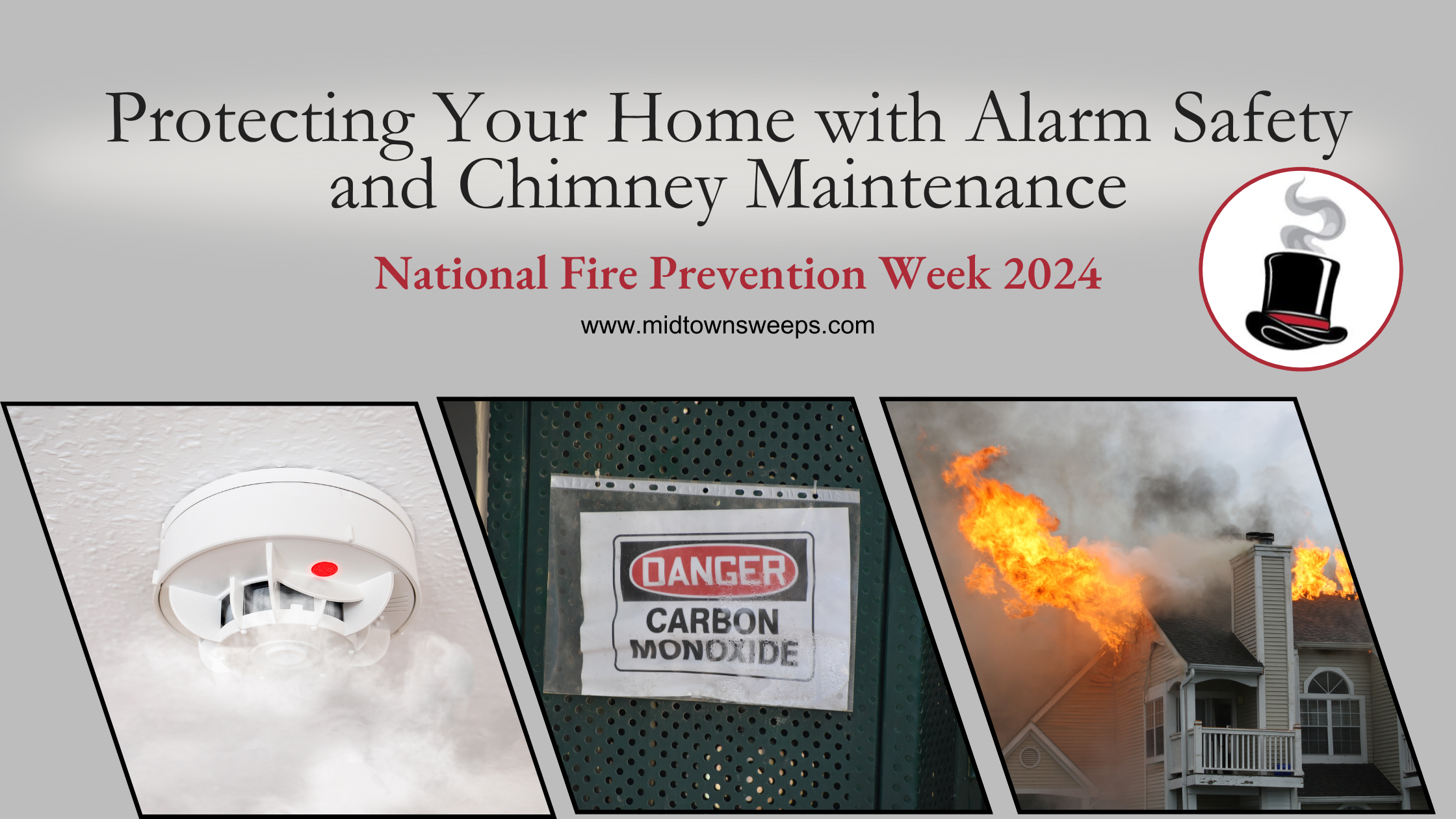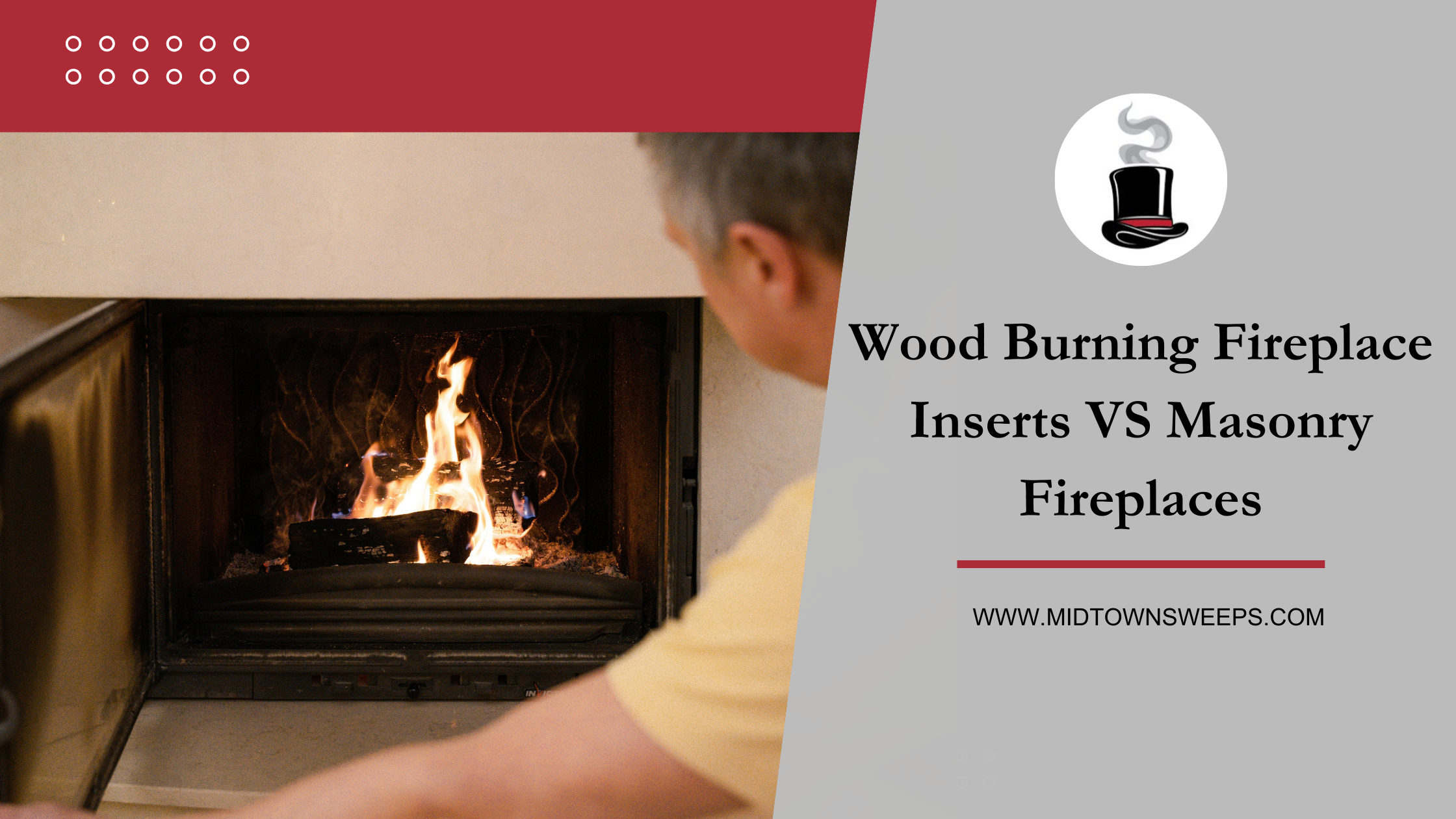National Fire Prevention Week 2024
As chimney experts at Midtown Chimney Sweeps, we take great pride in our role in preventing chimney fires and ensuring that homeowners can safely enjoy their fireplaces throughout the colder months. Let’s explore the importance of smoke and carbon monoxide alarms and how to ensure they work for you. Fire prevention and maintaining your chimney is key to keeping your home safe and these alarms can save your life.
What Is National Fire Prevention Week?
Every October, communities across the country come together to observe National Fire Prevention Week (NFPW), which a vital campaign dedicated to raising awareness about fire safety and prevention. Established in 1925, it’s the longest-running public health and safety initiative in the U.S. This year, from October 6th to October 12th, 2024, the theme is “Smoke Alarms: Make them Work for You!”
Small actions can make a big difference in preventing fires at home. While smoke alarms are a crucial first line of defense in detecting fires and saving lives, there’s more to fire safety than installing an alarm. Midtown Chimney Sweeps believes that chimney maintenance plays a key role in fire prevention, ensuring that your home heating systems—like fireplaces, wood stoves, and chimneys—are safe and ready for use during the colder months.
Let’s explore the importance of smoke alarms (and carbon monoxide detectors), how chimney maintenance contributes to fire prevention, and actionable steps you can take to protect your home and family.
Smoke Alarms: Your First Line of Defense
Smoke alarms are critical to early fire detection, giving you the precious minutes needed to escape a fire safely. According to the National Fire Protection Association (NFPA), having a working smoke alarm cuts the risk of dying in a fire by half. However, simply having smoke alarms in your home isn’t enough—they need to be maintained and tested regularly.
Here’s how you can make smoke alarms work for you:
1. Install Smoke Alarms in Key Areas
- Place alarms in every bedroom, outside sleeping areas, and on every level of your home (including the basement).
- If you have a fireplace or wood stove, ensure there is a smoke alarm nearby to catch any signs of trouble early.
2. Test Your Alarms Monthly
- Smoke alarms should be tested at least once a month to ensure they’re functioning properly. A simple push of the test button can confirm that your alarm is in good working condition.
3. Replace Batteries Regularly
- Most smoke alarms use replaceable batteries. Most smoke detectors have a low-battery chirp that can let you know when the battery needs to be replaced. The best practice is to make it a habit to change the batteries at least once a year.
4. Replace Your Alarms Every 10 years
- All smoke alarms should be replaced every 10 years. This can include those whose batteries have been updated yearly. If your smoke alarm stops responding when tested, it should be replaced immediately.

Carbon Monoxide Detectors: A Critical Companion to Smoke Alarms
While smoke alarms alert you to the presence of fire, carbon monoxide (CO) detectors are just as important in keeping your home safe. Carbon monoxide is a silent killer—it’s an odorless, colorless gas produced by burning fuel in appliances like fireplaces, wood stoves, furnaces, and gas water heaters. Without proper ventilation, CO can build up in your home and become lethal.
Here’s why carbon monoxide detectors are essential:
1. Detecting Invisible Dangers
Unlike smoke or fire, carbon monoxide can’t be seen or smelled, making it incredibly dangerous. Installing CO detectors near bedrooms and living areas ensures that you’ll be alerted if unsafe levels of the gas are present.
2. Pairing CO Detectors with Heating Systems
For homes with wood stoves or fireplaces, CO detectors are a must. Burning wood or fossil fuels can produce carbon monoxide, especially if the chimney isn’t venting properly. Having detectors in key locations provides an additional layer of protection.
3. Testing and Maintenance
Just like smoke alarms, CO detectors need to be tested regularly. Monthly tests and annual battery changes will ensure that your detectors are functioning properly.
4. Combination Alarms
Consider installing combination smoke and carbon monoxide alarms to cover both risks in a single device, offering comprehensive protection with fewer devices to manage.

The History and Purpose of National Fire Prevention Week
National Fire Prevention Week is rooted in a historical event that shaped fire safety standards in America—the Great Chicago Fire of 1871. This devastating fire killed over 250 people, destroyed more than 17,000 structures, and left 100,000 people homeless. In the wake of this tragedy, awareness about fire prevention grew, eventually leading to the establishment of Fire Prevention Week by the National Fire Protection Association (NFPA).
Each year, NFPW aims to educate the public on ways to reduce the risk of fire in homes, schools, and workplaces. It’s a reminder for all of us to take proactive measures to protect our families and properties.
Chimney Fires: A Hidden Danger in Your Home
Chimneys and fireplaces are beloved sources of warmth during the colder months, but they can also pose significant fire hazards if not properly maintained. Chimney fires are one of the leading causes of house fires, and many homeowners are unaware of the risks lurking within their chimneys.
What Causes Chimney Fires?
The primary cause of chimney fires is the buildup of creosote, a highly flammable substance that forms inside the chimney as wood burns. Creosote buildup can ignite, causing flames to climb up the chimney and potentially spread to the rest of the home.
Other causes of chimney fires include:
- Blockages from bird nests, debris, or leaves
- Cracked flue liners that allow heat and flames to escape into vulnerable areas
- Improper installation of wood stoves and fireplaces
Many homeowners may not realize that their chimneys need regular cleaning and inspection to remove these hazards. Without proper maintenance, the risk of a chimney fire significantly increases.
How Chimney Maintenance Prevents Fires
At Midtown Chimney Sweeps, we specialize in keeping your chimney safe and efficient, which is a critical part of fire prevention. Here’s how routine chimney care can prevent dangerous fires:
1. Creosote Removal
Annual chimney cleaning is essential to remove creosote buildup. So, depending on the type of wood you burn and how often you use your fireplace, creosote can accumulate quickly. Professional chimney sweeps use specialized tools to thoroughly clean out creosote, reducing the risk of a chimney fire.
2. Inspection for Structural Damage
A chimney inspection helps identify cracks, gaps, or wear in the chimney liner and masonry. Also, damaged liners allow flames and embers to escape into the home’s walls, leading to potential house fires. Regular inspections catch these issues before they become major problems.
3. Ensuring Proper Ventilation
Blockages in the chimney flue can prevent smoke and dangerous gases like carbon monoxide from escaping your home. This means that a clear, unobstructed chimney ensures proper airflow and safe operation of your fireplace or wood stove.
4. Detecting Chimney Blockages
Our team at Midtown Chimney Sweeps also inspects for blockages caused by debris, bird nests, and other obstructions. It’s important because these blockages can prevent proper ventilation, leading to dangerous smoke buildup inside your home.
By scheduling an annual chimney inspection and cleaning, homeowners can significantly reduce the risk of fires and ensure that their chimney system is functioning safely.
Understanding Chimney Fire Statistics
Chimney fires are more common than many people realize. According to the NFPA, an average of 25,000 chimney fires occur in the United States every year, causing over $125 million in property damage. Most of these fires are entirely preventable with routine maintenance and awareness.
Key Statistics:
- Chimney fires are responsible for thousands of home fires each year.
- Over 30% of all heating fires are linked to chimneys and fireplaces.
- Many of these fires occur during the fall and winter months, when fireplaces are in regular use.
These statistics emphasize the importance of proactive chimney care, particularly during Fire Prevention Week when fire safety is top of mind.
Midtown Chimney Sweeps: Your Partners in Fire Prevention
At Midtown Chimney Sweeps, we are committed to helping homeowners maintain a safe living environment through our comprehensive chimney cleaning and inspection services. Here’s what we offer to ensure your chimney and fireplace are ready for the winter season:
1. Qualified Chimney Sweeps
Our team is trained and certified by a handful of accredited and in-house certification such as National Fireplace Institute (NFI), Certified Chimney Professional (CCP), and Chimney and Hearth Inspection Mastery (CHIM). This means we adhere to the highest safety standards to ensure your chimney is properly cleaned and inspected.
2. Advanced Cleaning Techniques
Using specialized tools like chimney brushes, rotary cleaning systems, and vacuums, our Midtown team provides thorough creosote removal to minimize fire hazards.
3. Full-Service Chimney Inspections
Our comprehensive chimney inspections include checking the chimney liner, masonry, chimney cap, and venting system. We use video scanning technology to examine the interior of your chimney and identify any hidden issues.
4. Repairs and Maintenance
If we identify any damage during the inspection, we offer repair services to address structural issues, liner cracks, and other hazards that could compromise the safety of your chimney.
We believe that every homeowner deserves peace of mind when using their fireplace. That’s why we are proud to play a role in fire prevention during this important week and beyond.
Fire Safety Tips for Homeowners
As part of National Fire Prevention Week, we encourage homeowners to take the following steps to improve fire safety in their homes:
1. Schedule Your Annual Chimney Cleaning
First, make it a priority to schedule an annual chimney inspection and cleaning. The fall season is the perfect time to ensure your fireplace is safe and ready for winter use.
2. Install Smoke and Carbon Monoxide Detectors
Next, make sure to install smoke and carbon monoxide detectors in every level of your home, especially near sleeping areas. These detectors provide an early warning in case of fire or gas leaks.
3. Use Seasoned Firewood
Thirdly, burning seasoned, dry firewood reduces the amount of creosote that forms in your chimney. Avoid burning green or wet wood, which produces more smoke and creosote buildup.
4. Install a Chimney Cap
It’s important to install a chimney cap, as it helps prevent debris, animals, and rain from entering your chimney. This will reduce the risk of blockages and water damage.
5. Follow Proper Fire Safety Practices
Lastly, always use a fireplace screen to prevent sparks from escaping, and never leave a fire unattended. Keep flammable materials like furniture, drapes, and paper at least three feet away from your fireplace.
Take Action During National Fire Prevention Week 2024
This National Fire Prevention Week, take a moment to ensure that both your smoke alarms, carbon monoxide detectors, and chimney are in top shape. By combining the power of working alarms with the benefits of regular chimney maintenance, you’re taking the best steps to protect your home and family from fire and CO risks.
Take the time to book your annual chimney inspection and cleaning today. Contact Midtown Chimney Sweeps to ensure your home is well-prepared for the colder months ahead—and that your family stays safe during National Fire Prevention Week and beyond.












